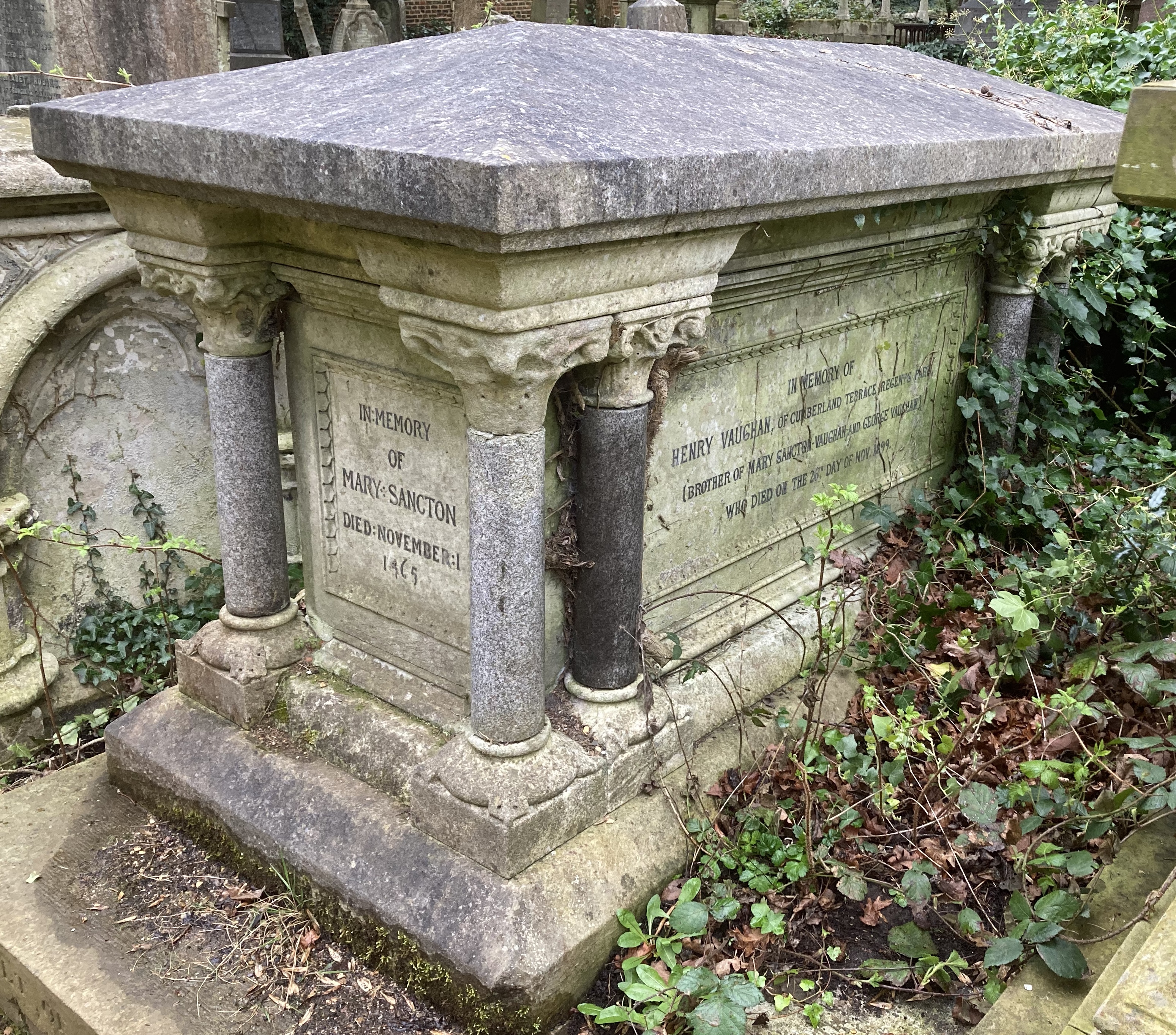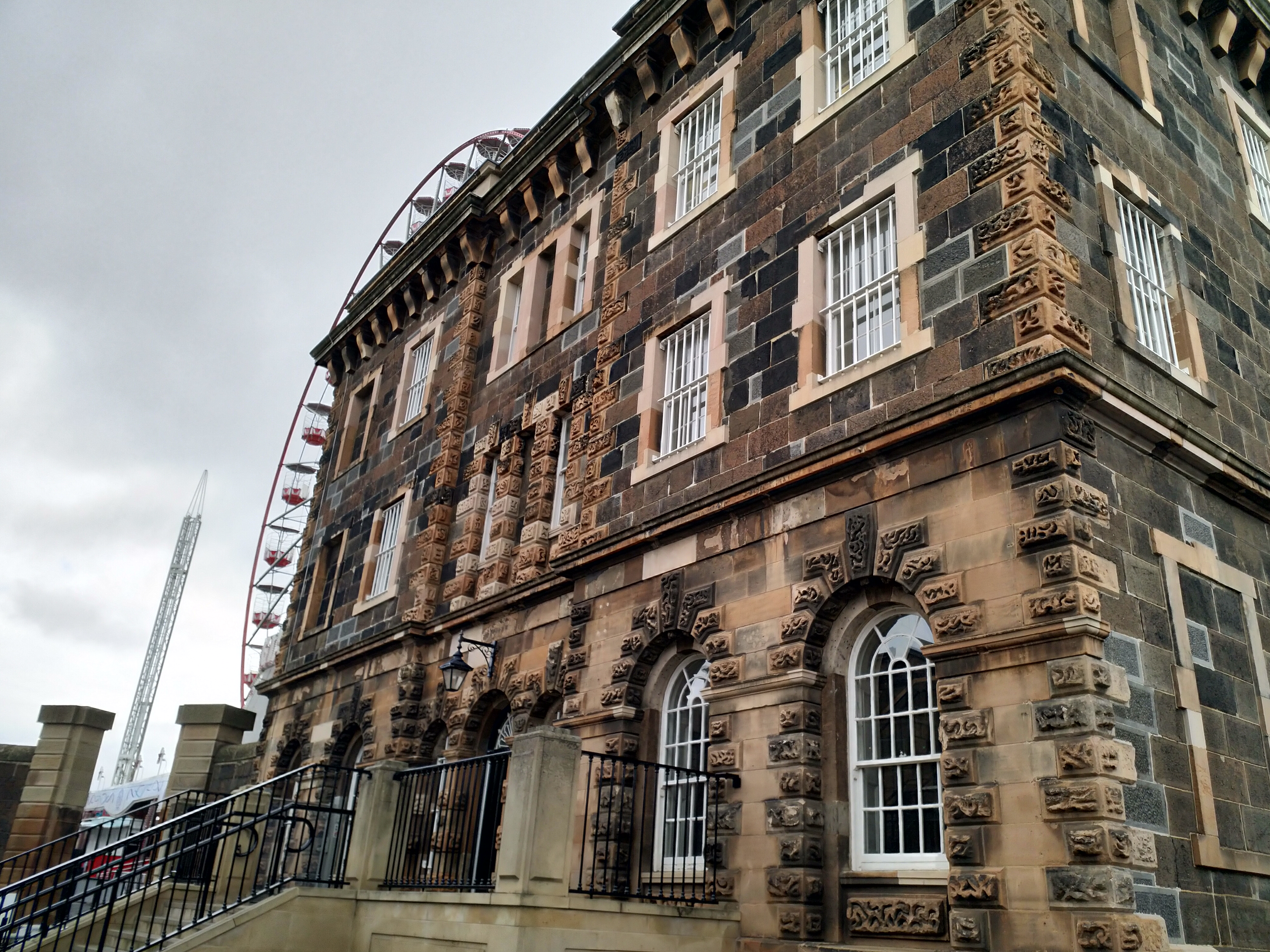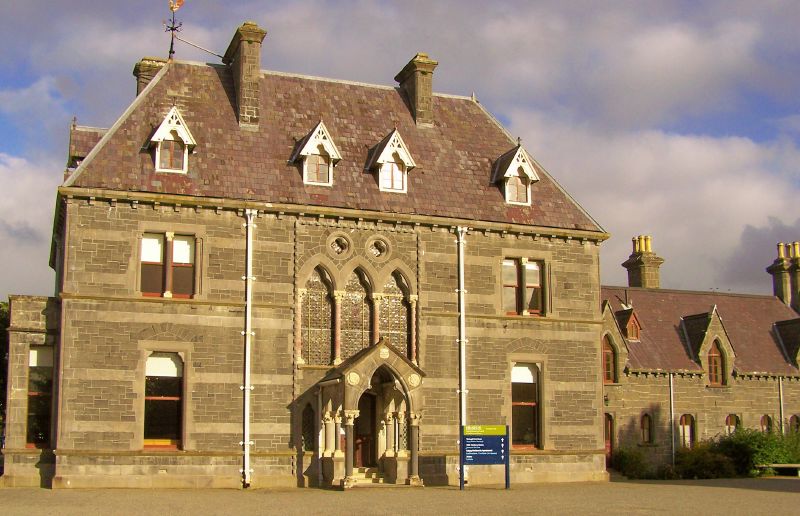|
National Gallery Ireland
The National Gallery of Ireland () houses the national collection of Irish and European art. It is located in the centre of Dublin with one entrance on Merrion Square, beside Leinster House, and another on Clare Street. It was founded in 1854 and opened its doors ten years later. The gallery has an extensive, representative collection of Irish paintings and is also notable for its Italian Baroque and Dutch masters painting. The current director is Caroline Campbell. History In 1853 an exhibition, the Great Industrial Exhibition, was held on the lawns of Leinster House in Dublin. Among the most popular exhibits was a substantial display of works of art organised and underwritten by the railway magnate William Dargan. The enthusiasm of the visiting crowds demonstrated a public appreciation for art, and it was decided to establish a permanent public art collection as a lasting monument of gratitude to Dargan. The moving spirit behind the proposal was the barrister John Edward P ... [...More Info...] [...Related Items...] OR: [Wikipedia] [Google] [Baidu] |
Dublin
Dublin is the capital and largest city of Republic of Ireland, Ireland. Situated on Dublin Bay at the mouth of the River Liffey, it is in the Provinces of Ireland, province of Leinster, and is bordered on the south by the Dublin Mountains, part of the Wicklow Mountains range. Dublin is the largest city by population on the island of Ireland; at the 2022 census of Ireland, 2022 census, the city council area had a population of 592,713, while the city including suburbs had a population of 1,263,219, County Dublin had a population of 1,501,500. Various definitions of a metropolitan Greater Dublin Area exist. A settlement was established in the area by the Gaels during or before the 7th century, followed by the Vikings. As the Kingdom of Dublin grew, it became Ireland's principal settlement by the 12th century Anglo-Norman invasion of Ireland. The city expanded rapidly from the 17th century and was briefly the second largest in the British Empire and sixth largest in Western Europ ... [...More Info...] [...Related Items...] OR: [Wikipedia] [Google] [Baidu] |
Great Industrial Exhibition (1853)
The Great Industrial Exhibition in 1853 was held in Dublin, Ireland. In its day, it was the largest international event to be held in Ireland. The Irish Industrial Exhibition Building, located on the grounds of Leinster House, housed the entire fair. It lasted from 12 May to 31 October, Queen Victoria accompanied by the Prince Consort and the Prince of Wales, paid an official visit on 29 August. Background It was entirely funded by William Dargan, entrepreneur and developer of Irish railways. He had planned to donate $100,000 to the effort, but ended up giving $400,000. The intent of the exhibition was to introduce the industrial revolution to Ireland, which was behind some other European countries. Irish Industrial Exhibition Building Visitors were struck with the quality of the building more than by any of the objects that it contained. Critics described the large exhibition building and "the rapidity with which it was erected" (a few months), and "the sufficiency of its plans ... [...More Info...] [...Related Items...] OR: [Wikipedia] [Google] [Baidu] |
Hugh Lane Gallery
The Hugh Lane Gallery, and originally the Municipal Gallery of Modern Art, is an art museum operated by Dublin City Council and its wholly-owned company, the Hugh Lane Gallery Trust. It is in Charlemont House (built 1763) on Parnell Square, Dublin, Ireland. Admission is free. History The gallery was founded by noted art collector Sir Hugh Lane on Harcourt Street on 20 January 1908, and is the first known public gallery of modern art in the world. Lane met the running costs, while seeking a more permanent home. New buildings were proposed in St. Stephens Green, and as a dramatic bridge-gallery over the River Liffey, both proposed designs by Sir Edwin Lutyens, both unrealised. Lane did not live to see his gallery permanently located as he died in 1915 during the sinking of the RMS ''Lusitania''. Since 1933 it has been housed in Charlemont House. Lane's will bequeathed his collection to London, but an unwitnessed codicil, written in the months prior to his death, bequeathe ... [...More Info...] [...Related Items...] OR: [Wikipedia] [Google] [Baidu] |
Hugh Lane
Sir Hugh Percy Lane (9 November 1875 – 7 May 1915) was an Irish art dealer, collector and gallery director. He is best known for establishing Dublin's Municipal Gallery of Modern Art (the first known public gallery of modern art in the world) and for his contribution to the visual arts in Ireland, including the Lane Bequest. Hugh Lane died on board the RMS ''Lusitania''. Family Hugh Percy Lane was born in County Cork, Ireland, on 9 November 1875. He was the son of a rector father, James William Lane. His mother, Frances Adelaide (Persse) Lane, was a daughter of Dudley Persse, of Roxborough, County Galway. Her sister, Augusta, was the dramatist Augusta, Lady Gregory, of Coole, County Galway. He was brought up in Cornwall, England, and began his career as an apprentice painting restorer with Martin Henry Colnaghi in London, then worked as an art dealer at the Colnaghi's Marlborough Gallery for some years, before becoming a dealer in his own right and opening a gallery ... [...More Info...] [...Related Items...] OR: [Wikipedia] [Google] [Baidu] |
Henry Vaughan (art Collector)
Henry Vaughan (17 April 1809 – 26 November 1899) was a British art collector. He is best known for his many generous gifts and bequests to British and Irish public collections. Early life Henry Vaughan, who was born in Southwark, London on 17 April 1809, was the son of a successful hat manufacturer, George Vaughan, and his wife Elizabeth Andrews.Herrmann, L. (23 September 2004). Vaughan, Henry (1809–1899), art collector. Oxford Dictionary of National Biography. Retrieved 31 Mar. 2021, from https://www.oxforddnb.com/view/10.1093/ref:odnb/9780198614128.001.0001/odnb-9780198614128-e-28131 Henry and his elder brother and sister, George and Mary, were brought up as Quakers. He attended a school at Higham Hill, Walthamstow, run by Eliezer Cogan, where a fellow pupil was Benjamin Disraeli. On the death of his father in 1828, Henry inherited a large fortune and thereafter lead what could be thought of as a rather self-indulgent life, but he went on to become one of the most dis ... [...More Info...] [...Related Items...] OR: [Wikipedia] [Google] [Baidu] |
Thomas Newenham Deane
Sir Thomas Newenham Deane (1828 – 8 November 1899) was an Irish architect, the son of Sir Thomas Deane and Eliza Newenham, and the father of Sir Thomas Manly Deane. His father and son were also architects. Works attributed to Thomas Newenham Deane, and his architectural practice, include the National Library of Ireland, a wing of the National Gallery of Ireland, St Mary's Cathedral, Tuam, the Kildare Street Club, and a number of buildings in the Trinity College Dublin campus. Early life Sir Thomas Newenham Deane was born on the 15 of June in 1828 near Cork, Ireland. He was the son of Sir Thomas Deane, an architect, and Eliza O’Callaghan Newenham, Sir Thomas Deane's second wife. Deane was born as the oldest of 3 siblings. As the only son Deane had two younger sisters, Susanna Adelaide (Ada) and Olivia Louisa. From his father's first marriage the three siblings had a step-brother John Connellan and a step-sister Julia Connellan. Deane is described as being a shy and ... [...More Info...] [...Related Items...] OR: [Wikipedia] [Google] [Baidu] |
Russborough House
Russborough House is a Georgian Palladian house between Blessington and Ballymore Eustace near the Blessington Lakes in County Wicklow, Ireland. The house was designed by Richard Castle for Joseph Leeson, 1st Earl of Milltown and built between 1741 and 1755. It has an exceptionally long frontage measuring . The interior contains fine ornate plasterwork on the ceilings by the Lafranchini brothers, who also collaborated with Castle on Carton House. Russborough contains an important private collection of European fine and decorative arts, including furniture, silver, porcelain and paintings many of which have now been transferred to galleries for safe keeping. Russborough is open to visitors and is located on a estate, with many of the original 18th-century features still in place including the walled garden, ice-house, lime kiln and the serpentine lakes. There is also a restaurant, shop and maze. History Leeson family ownership The Leeson family originated from near Cul ... [...More Info...] [...Related Items...] OR: [Wikipedia] [Google] [Baidu] |
Charles Lanyon
Sir Charles Lanyon Deputy Lieutenant, DL, Justice of the Peace, JP (6 January 1813 – 31 May 1889) was an English Architecture, architect of the 19th century. His work is most closely associated with Belfast, Northern Ireland. Biography Lanyon was born in Eastbourne, Sussex (now East Sussex) in 1813. His father was John Jenkinson Lanyon, a purser in the Royal Navy, and his mother was Catherine Anne Mortimer. Following his education, he became an apprentice civil engineer with Jacob Owen in Portsmouth. When Owen was made senior Engineer and Architect of the Irish Board of Works and moved to Dublin, Lanyon followed. In 1835, after the Napoleonic Wars, he married Owen's daughter, Elizabeth Helen. They had ten children, including Sir William Owen Lanyon, an army officer and colonial administrator. Charles Lanyon was county surveyor[2] in Kildare briefly, before moving on to Antrim in 1836. He remained county surveyor of Antrim until 1860 Before the American Civil War when he resig ... [...More Info...] [...Related Items...] OR: [Wikipedia] [Google] [Baidu] |
Francis Fowke
Francis Fowke (7 July 1823 – 4 December 1865) was an Irish engineer and architect, and a captain in the Corps of Royal Engineers. Most of his architectural work was executed in the Renaissance style, although he made use of relatively new technologies to create iron framed buildings, with large open galleries and spaces. Fowke was born in Ballysillan, Belfast. He studied at The Royal School Dungannon, County Tyrone, and the Royal Military Academy, Woolwich. He obtained a commission in the Royal Engineers, and served with distinction in Bermuda and Paris. On his return to England, he was appointed architect and engineer in charge of the construction of several government buildings. Among his projects were the Prince Consort's Library in Aldershot, the Royal Albert Hall and parts of the Victoria and Albert Museum in London, the Industrial Museum of Scotland (Edinburgh Museum of Science and Art) in Edinburgh, and the National Gallery of Ireland in Dublin. He was also resp ... [...More Info...] [...Related Items...] OR: [Wikipedia] [Google] [Baidu] |
National Museum Of Ireland
The National Museum of Ireland () is Ireland's leading museum institution, with a strong emphasis on national and some international archaeology, Irish history, Irish art, culture, and natural history. It has three branches in Dublin, the archaeology and natural history museums adjacent on Kildare Street and Merrion Square, and a newer Decorative Arts and History branch at the former Collins Barracks, and the Country Life museum in County Mayo. History Predecessors The National Museum of Ireland descends from the amalgamation of parts of the collections of a number of Dublin cultural institutions from the 18th and 19th centuries, including primarily the Royal Dublin Society (RDS) and the Royal Irish Academy (RIA). The earliest parts of the collections are largely geological and mineralogical specimens, which the RDS collected as a means to improve the knowledge and use of such resources in Ireland. The establishment of the museum collections is generally deemed to have ... [...More Info...] [...Related Items...] OR: [Wikipedia] [Google] [Baidu] |
Chief Baron Of The Irish Exchequer
The Chief Baron of the Irish Exchequer was the Baron (judge) who presided over the Irish Court of Exchequer. This was a mirror of the equivalent court in England, and was one of the four courts which sat in the building in Dublin which is still called The Four Courts. The title Chief Baron was first used in 1309 by Walter de Islip. In the early centuries of its existence, it was a political as well as a judicial office, and as late as 1442 the Lord Treasurer of Ireland thought it necessary to recommend that the Chief Baron should always be a properly trained lawyer (which Michael Gryffin, the Chief Baron at the time, was not). There are two cryptic references in the Patent Rolls, for 1386 and 1390, to the Liberty of Ulster having its own Chief Baron. The last Chief Baron, The Rt Hon. Christopher Palles, continued to hold the title after the Court was merged into a new High Court of Justice in Ireland The High Court of Justice in Ireland was the court created by the ... [...More Info...] [...Related Items...] OR: [Wikipedia] [Google] [Baidu] |
David Richard Pigot
David Richard Pigot, Privy Council of Ireland, PC, King's Counsel, KC (c. 1796 – 22 December 1873) was one of the leading Irish judges of his time. His children included John Edward Pigot, a noted music collector and one of the founders of the National Gallery of Ireland. His grandchildren included the Australian astronomer and Jesuit Edward Pigot. Life Pigot was born at Park House, in Kilworth, County Cork, the only son of John Pigot, a doctor of Physic of high reputation, and his wife Margaret Nagle. He went to school in Fermoy and graduated from Trinity College Dublin. Originally he intended to follow his father's profession, and studied medicine in Edinburgh. He then decided on a career in the law, was Call to the Bar, called to the Bar in 1826 and became King's Counsel in 1835. He represented Daniel O'Connell in the unsuccessful effort to prosecute him in 1831, and in later life, he was one of the few judges of whom O'Connell spoke highly. He was appointed Solicitor-Genera ... [...More Info...] [...Related Items...] OR: [Wikipedia] [Google] [Baidu] |





